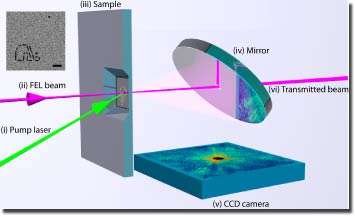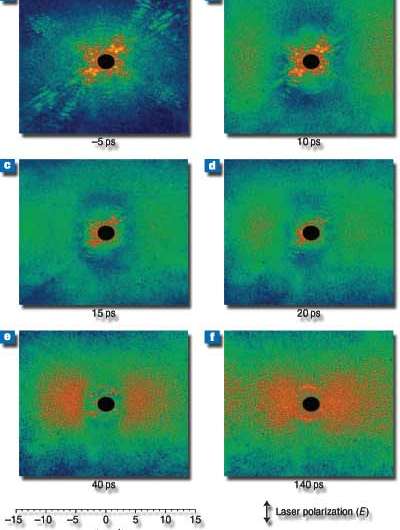A look into the nanoscale

Lawrence Livermore National Laboratory researchers have captured time-series snapshots of a solid as it evolves on the ultra-fast timescale.
Using femtosecond X-ray free electron laser (FEL) pulses, the team, led by Anton Barty, is able to observe condensed phase dynamics such as crack formation, phase separation, rapid fluctuations in the liquid state or in biologically relevant environments.
Other Livermore scientists include Michael Bogan, Stafan Hau-Riege, Stefano Marchesini, Matthias Frank, Bruce Woods, former Livermore researcher Saša Bajt and former LLNL scientist Henry Chapman, who is now at the Centre for Free Electron Laser Science, DESY, in Hamburg, Germany.

“The ability to take images in a single shot is the key to studying non-repetitive behavior mechanisms in a sample,” Barty said.
As the femtosecond laser blasts the sample, it is destroyed, but not before the scientists created images with a 50-nanometer spatial resolution, and a 10-femtosecond shutter speed. (A femtosecond is one billionth of one millionth of a second. For context, a femtosecond is to a second as a second is to about 32 million years.)
“This experiment opens the door to a new regime of time-resolved experiments in mesoscopic dynamics,” Barty said. “This technique could be extended to a few nanometers spatial and a few tens of femtoseconds temporal resolution.”
This is the first time that optical pulses have been used to image samples at the nanometer-spatial resolution scale. Earlier studies were limited to a few micrometers.
The “shutter speed” of the measurements is determined by the femtosecond duration of the FEL X-ray pulse. This allowed the team to obtain nanometer spatial resolution of violent and destructive events in which the sample is completely destroyed.
The new technique is necessary to study ultrafast dynamics of non crystalline materials at nanometer-length scales.
This includes fracture dynamics, shock formation, spallation, ablation and plasma formation under extreme conditions.
The technique also allows researchers to image dynamic process in the solid state such as nucleation and phase growth, phase fluctuations and various forms of electronic or magnetic segregation.
The research appears in the June 22 online edition of Nature Photonics.
Source: Lawrence Livermore National Laboratory





















